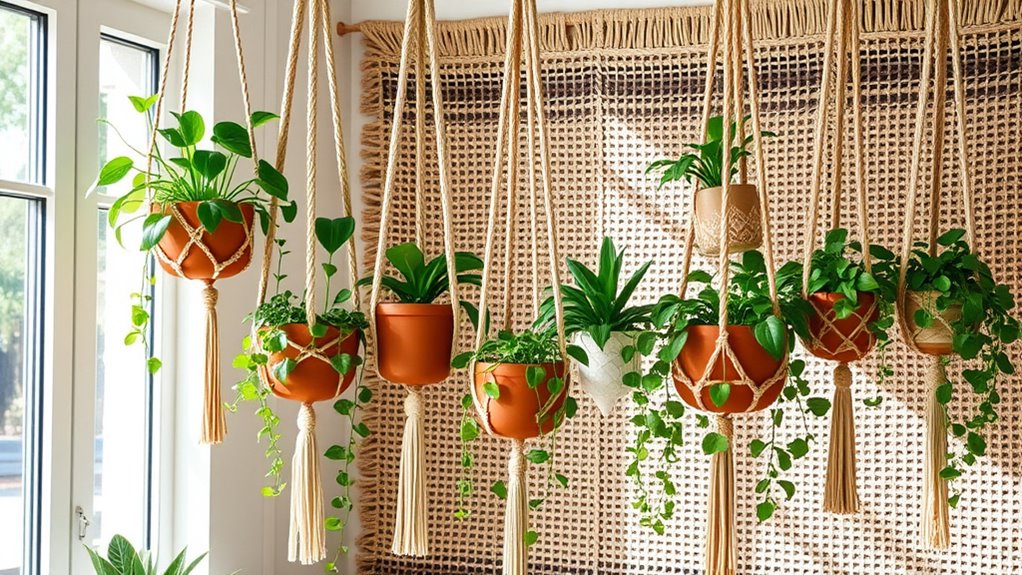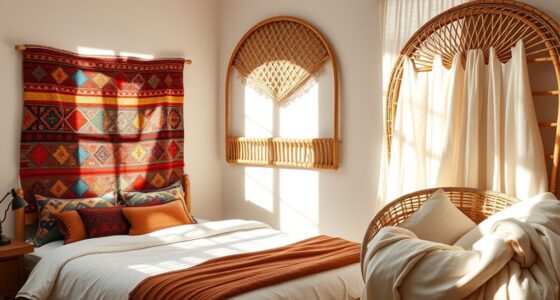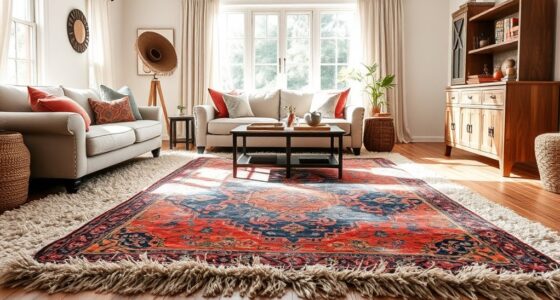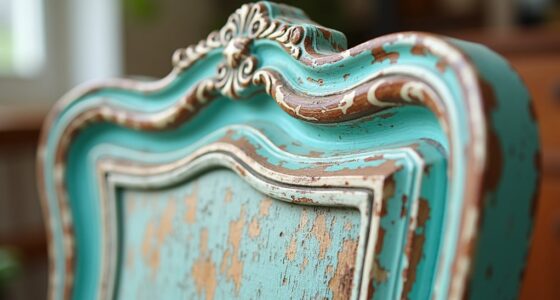To create your plant paradise, start by gathering eco-friendly cords, wooden beads, and sturdy tools like scissors and measuring tape. Follow a step-by-step process to knot and finish your macramé plant hangers, choosing vibrant or neutral colors to match your style. Get creative with unique shapes, layered textures, and personalized touches. For the best results, select plants and pots that complement your decor. Keep exploring for tips to craft stunning, eco-friendly planters that truly elevate your space.
Key Takeaways
- Learn step-by-step techniques for creating eco-friendly, stylish macramé plant hangers with precise measuring and knotting methods.
- Incorporate decorative accents like wooden beads and shells to personalize your boho planters.
- Select suitable plant pots based on plant size, light needs, and overall aesthetic harmony for a balanced look.
- Use sustainable materials such as organic cotton, jute, or reclaimed fibers to ensure durability and eco-friendliness.
- Enhance your space with handmade, layered decor and varied hanger styles for a cohesive boho-inspired plant paradise.
Essential Materials and Tools for Macramé Masterpieces
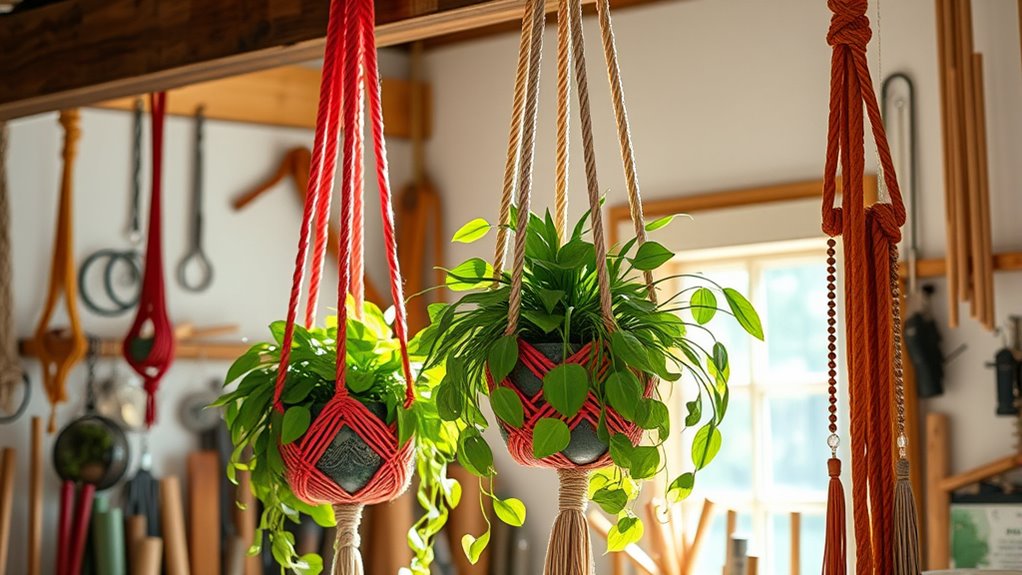
To create stunning macramé plant hangers and boho planters, you’ll need the right materials and tools. Prioritize sustainable sourcing by choosing eco-friendly cords made from organic cotton, jute, or recycled fibers. These materials not only support environmental efforts but also add natural texture to your designs. When selecting cords, consider your desired color palettes—neutral tones like beige, white, or earthy browns work well for a minimalist look, while vibrant shades can add personality. You’ll also need basic tools such as scissors, a measuring tape, and a sturdy surface for knotting. Investing in high-quality materials guarantees your projects are durable and beautiful, while eco-conscious choices align with responsible crafting. With the right essentials, you’re all set to begin your macramé journey.
Step-by-Step Guide to Crafting Your First Macramé Plant Hanger
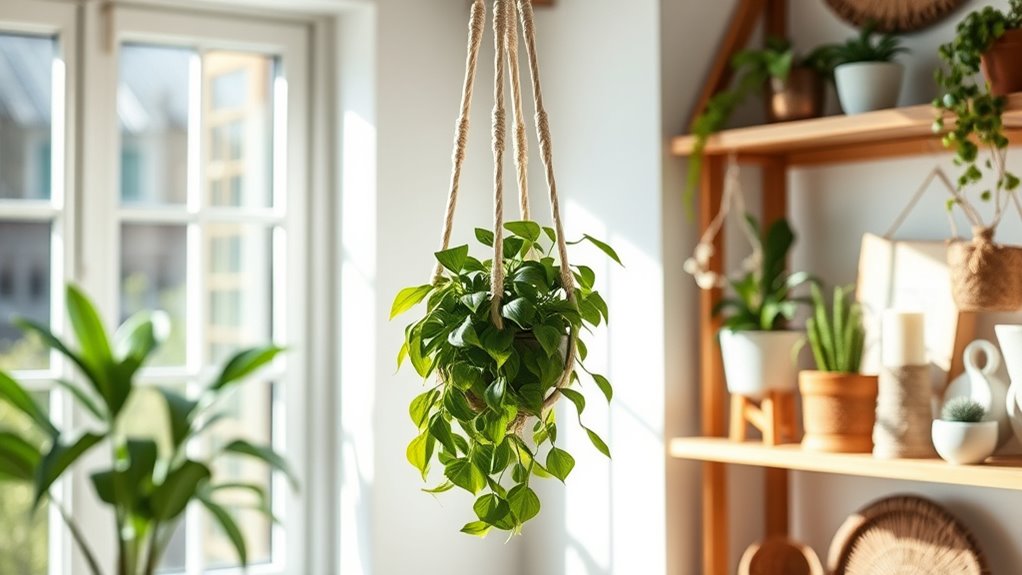
Start by gathering all your materials and tools, making sure you have everything within reach. Measure and cut your cords to the right lengths, then follow the knotting techniques to create your design. Finish your hanger with neat knots and secure ends for a polished look.
Gather Materials and Tools
Gathering the right materials and tools is the essential first step in creating your own macramé plant hanger. Start with sustainable materials like organic cotton cords or hemp, which are eco-friendly and durable. Choose cords in colors that complement your decor, and consider adding decorative accents such as wooden beads or shells to personalize your hanger. You’ll need a sturdy pair of scissors to cut the cords, a measuring tape for accuracy, and a simple dowel or ring to serve as the hanger’s top. Having these tools and materials ready guarantees a smooth crafting process. Prioritize quality, especially with your cords, to ensure your finished piece is both beautiful and long-lasting. With everything in place, you’re ready to start knotting and creating your boho-inspired planter.
Measure and Cut Lengths
Before you begin knotting, it’s important to measure and cut your cords accurately. Measuring precisely ensures your plant hanger will have the correct length and symmetry. Use a ruler or measuring tape to determine the lengths needed for each cord, considering the desired height and style of your hanger. Once measured, cut each cord exactly using sharp scissors, avoiding frayed edges. Remember, uneven cuts can affect the overall look and stability. It’s helpful to cut all cords to the same length initially, then trim any uneven ends later if needed. Taking your time during this step guarantees a professional finish and makes knotting easier. Accurate measuring and cutting set a solid foundation for your macramé project, ensuring your plant hanger turns out just as you envisioned. Proper preparation, including material selection, is essential for a durable and attractive finished piece. Additionally, understanding knotting techniques can significantly improve the quality of your craft and the appearance of your hanger. Paying attention to measurement accuracy can also prevent the need for adjustments later in your project.
Knotting and Finishing Techniques
Once your cords are measured and cut, you can begin knotting to create the structure of your plant hanger. Start with basic knotting techniques like the square knot or lark’s head knot to build your design. Use consistent tension to guarantee even spacing and a neat look. As you work, incorporate decorative knots such as the spiral or diagonal half hitch for added style. When you reach the desired length, it’s time for finishing methods. Gather all cords together and secure them with a strong knot, like a gathering knot, to hold your planter securely. Trim excess cords evenly, and if you like, add a wooden bead or tassel for a polished touch. These knotting techniques and finishing methods give your macramé hanger stability and boho charm. For added rustic decor, consider integrating vintage or reclaimed elements into your planters or hangers. Additionally, practicing proper knot tension will ensure your finished piece is both durable and visually appealing.
Creative Ideas for Designing Unique Boho Planters
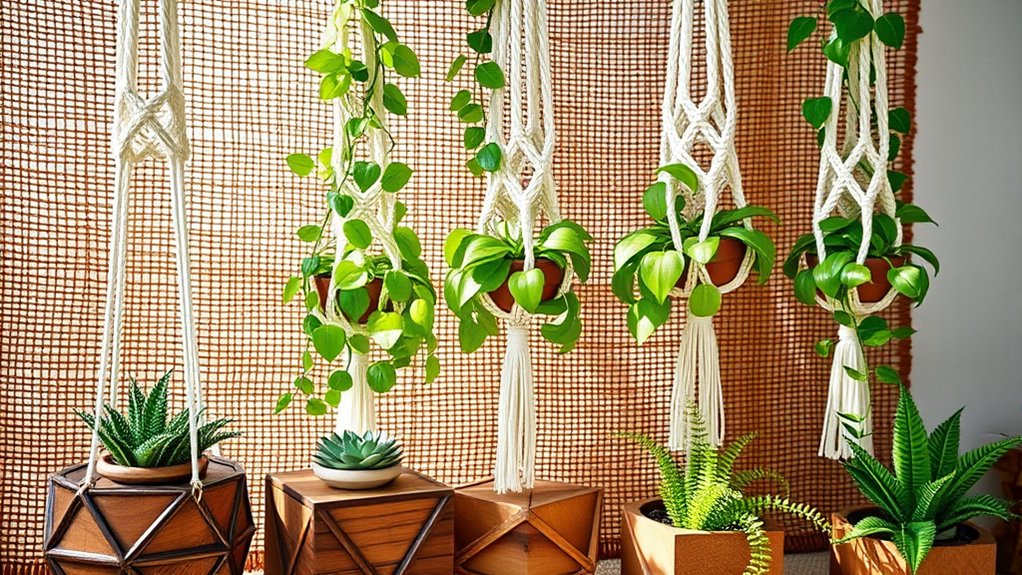
To create truly eye-catching boho planters, think beyond traditional designs and experiment with unexpected materials and shapes. Incorporate plant symbolism by choosing containers that reflect the personality or mood you want to evoke. For example, terracotta pots symbolize grounding and connection to earth, while textured ceramics add a boho vibe. Elevate your planters with botanical illustrations—hand-painted or printed designs that showcase leaves, flowers, or abstract plant motifs. These artistic touches personalize your space and add visual interest. Mix materials like woven fibers, metals, or reclaimed wood for a layered, eclectic look. By blending symbolism and botanical art, you craft planters that are not just containers but expressions of your style and appreciation for nature’s beauty. Additionally, understanding eco-friendly materials can further enhance the sustainability and charm of your boho planters, making them both stylish and environmentally conscious. Incorporating reclaimed wood or biodegradable components can also support eco-conscious decorating choices.
Tips for Choosing the Perfect Plants and Pots
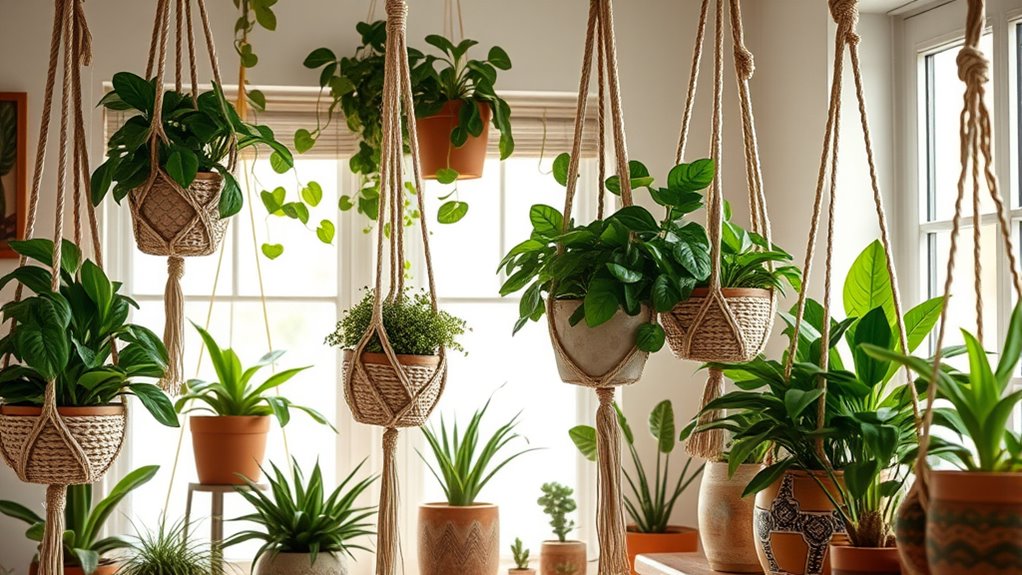
When selecting plants for your boho planters, consider their light needs to make certain they thrive in your space. Make sure the pot size matches the plant’s growth to keep everything balanced and healthy. Additionally, choosing pots that complement your style will help your planters fit seamlessly into your decor. To deepen your understanding of architectural features, explore historical farmhouse styles that highlight regional craftsmanship and design elements. Being aware of state tax implications can also influence your choices in material and placement, especially if you’re planning to create a large or elaborate display. Recognizing dog-friendly policies at local garden centers might also enhance your shopping experience, allowing you to bring your furry friend along while selecting your plants and pots.
Light Requirements
Choosing the right plants and pots for your macramé hangers depends heavily on their light needs. Consider whether your space offers ample natural sunlight or if you’ll rely on artificial plants and indoor lighting. Bright, direct sunlight suits succulents and cacti, while low-light spots are better for ferns and pothos. If your space has limited sunlight, opt for plants that thrive in shade or use grow lights. Keep in mind that some plants need consistent light, while others tolerate fluctuations. For a cozy, well-lit corner, select plants with similar light preferences to avoid frustration. Remember, matching your plant’s light needs with your environment guarantees healthier growth and vibrant greenery in your boho planters. Additionally, understanding the specific light requirements of your chosen plants can help you select the most suitable pots and placement, ensuring your greenery flourishes. Being aware of a plant’s aura color needs can also inform your selection, as certain colors are associated with particular light preferences and growth conditions. To further optimize plant health, consider the light intensity your space provides and adjust your plant choices accordingly.
Size Compatibility
Matching the size of your plants and pots is key to creating balanced and attractive boho planters. When selecting your plant, consider its mature size and growth habits to guarantee it fits well within the pot. Proper pot compatibility means choosing a container that provides enough room for roots to grow without being overly large, which can look disproportionate. A too-small pot can restrict growth and cause health issues, while a too-large pot can make your plant look lost and unkempt. For best results, pick a pot that comfortably accommodates your plant’s current size and allows for some growth. This balance enhances both the aesthetic appeal and the health of your plant, creating a harmonious, eye-catching display in your macramé hanger or boho planter. Additionally, selecting the right sized pots can help prevent overwatering or underwatering, ensuring your plant thrives. Proper drainage and watering habits are also crucial to maintain healthy plant growth and avoid root rot. Incorporating aesthetic wall organization ideas can further showcase your plants and enhance your overall decor.
Style Coordination
To achieve a cohesive and stylish look in your boho planters, you need to contemplate how the plants and pots complement each other’s design elements. Focus on matching color palettes to create harmony—soft neutrals, earthy tones, or vibrant hues can set different moods. Pay attention to material textures; smooth ceramics pair well with sleek leaves, while textured clay or woven baskets add tactile interest. Consider the overall aesthetic you want—modern, vintage, or eclectic—and select plants and pots accordingly. Additionally, incorporating vetted outdoor accessories can enhance the durability and visual appeal of your arrangements.
Styling Your Space With Handmade Macramé and Boho Decor
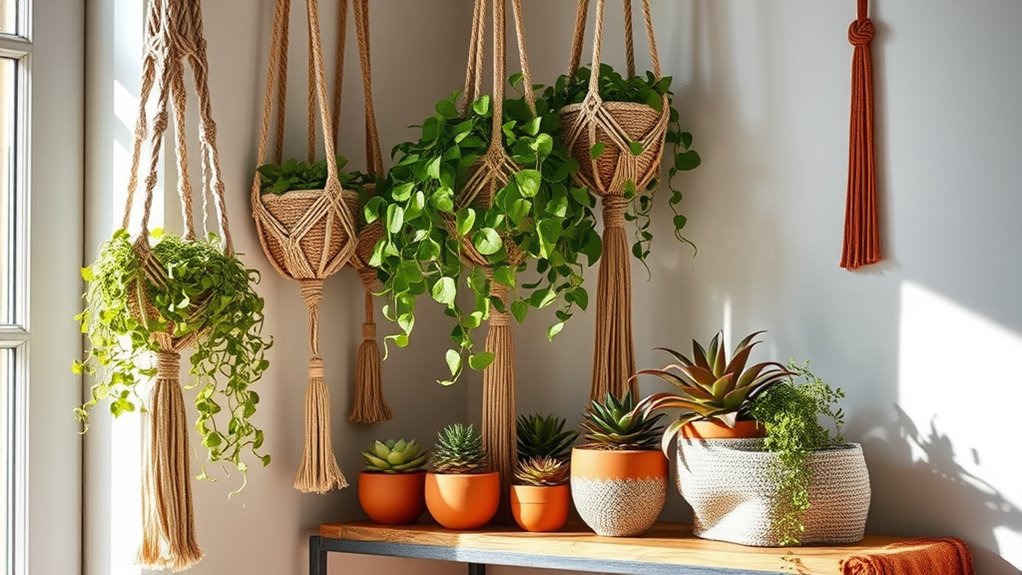
Adding handmade macramé plant hangers and boho-inspired planters can instantly transform your living space into a cozy, artistic retreat. Choose a harmonious color palette that complements your existing decor, whether earthy tones or vibrant accents, to create a cohesive look. These pieces add texture and visual interest, making your space feel layered and inviting. Incorporate smart storage solutions by hanging plants at different heights or grouping planters in designated areas, which helps keep your space organized and clutter-free. Mixing and matching different sizes and styles of hangers can add variety without overwhelming the room. This approach allows you to showcase your plants beautifully while maintaining a balanced, stylish environment that reflects your personality. For a truly personalized touch, consider exploring Preppy Dog Names that can inspire a playful or sophisticated theme in your decor. Additionally, understanding the jet boat market trends can inspire innovative ways to incorporate water-inspired elements or nautical accents into your boho decor, enhancing the overall aesthetic. Exploring sustainable materials can also ensure your decor remains eco-friendly and durable for years to come.
Maintenance and Care for Your DIY Plant Hangers and Planters
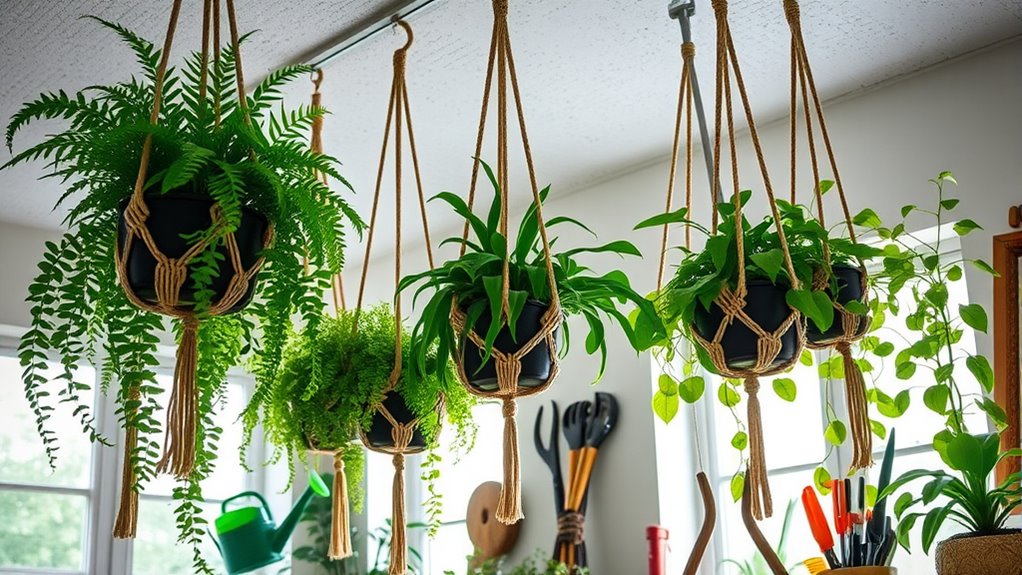
Once you’ve styled your space with beautiful handmade macramé hangers and boho planters, keeping them in great shape guarantees they continue to enhance your decor. Regular maintenance involves monitoring your plants’ watering schedules to prevent over- or under-watering. Check roots periodically for signs of pests, and remove any affected foliage promptly to prevent infestations. Keep your hangers clean by gently washing or spot-cleaning the cords to maintain their appearance. Make certain the planters drain well to avoid waterlogging, which can harm your plants. Additionally, inspect the hooks and knots for stability to prevent accidents. Proper greenhouse environment management can also help in maintaining the health of your plants and the durability of your hangers and planters. Ensuring optimal light conditions is essential for your plants’ growth and vitality. Consistently observing your plants’ growth conditions ensures they remain healthy and vibrant over time.
Frequently Asked Questions
What Are the Best Types of Plants for Hanging Planters?
When choosing the best plants for hanging planters, you should consider your indoor greenery and how much light they need. Popular options include pothos, spider plants, and Boston ferns, which thrive in hanging spots. Keep in mind plant care tips like watering frequency and light exposure to keep your plants healthy. With the right choices, your hanging planters will add vibrant, lush greenery to any space.
How Do I Prevent My Macramé Hangers From Stretching Over Time?
Imagine your macramé hangers gently sagging, like a hammock under a warm breeze. To prevent stretching, focus on material tension and knot security. Choose sturdy, high-quality cords and avoid overloading your hangers. Regularly check knots and tighten them if needed. Using thicker cords and reinforcing knots will keep your hangers taut over time, ensuring your plants stay beautifully showcased without sagging or stretching.
Can I Customize the Length of My Macramé Plant Hanger Easily?
You can easily customize the length of your macramé plant hanger using adjustment techniques. To make it longer or shorter, simply add or remove knots or beads at the desired spots. For precise length customization, measure your plant and hanging spot, then tailor the cords accordingly before knotting. This way, you guarantee your hanger fits perfectly and looks stylish, giving you full control over the final look and function.
What Safety Precautions Should I Take When Working With Sharp Tools?
When working with sharp tools, prioritize sharp tool safety by always handling them carefully and keeping blades or blades covered when not in use. Wear protective gear like gloves and safety glasses to prevent injuries. Keep your workspace organized, and pay close attention to your movements. Never rush, and store sharp tools securely after use. These precautions help minimize risks and ensure your crafting remains fun and injury-free.
Are There Eco-Friendly or Sustainable Materials for Macramé Supplies?
You’re curious about eco-friendly materials for macramé supplies, and the good news is you have options. You can choose recycled fibers, which help reduce waste, or biodegradable cords that break down naturally over time. These materials not only support sustainability but also add a unique touch to your projects. By selecting these eco-conscious options, you’re making a positive impact while creating beautiful, sustainable macramé pieces.
Conclusion
With your new macramé plant hangers and boho planters, your space transforms into a lush oasis bursting with personality. Think of your creations as the threads weaving together nature and art, turning your home into a vibrant garden sanctuary. Keep nurturing your skills and plants alike, and watch your boho paradise flourish like a wildflower field. Your home is now a handcrafted haven, where beauty and greenery grow side by side in perfect harmony.
